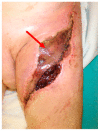Neoadjuvant Radiotherapy-Related Wound Morbidity in Soft Tissue Sarcoma: Perspectives for Radioprotective Agents
- PMID: 32806601
- PMCID: PMC7465163
- DOI: 10.3390/cancers12082258
Neoadjuvant Radiotherapy-Related Wound Morbidity in Soft Tissue Sarcoma: Perspectives for Radioprotective Agents
Abstract
Historically, patients with localized soft tissue sarcomas (STS) of the extremities would undergo limb amputation. It was subsequently determined that the addition of radiation therapy (RT) delivered prior to (neoadjuvant) or after (adjuvant) a limb-sparing surgical resection yielded equivalent survival outcomes to amputation in appropriate patients. Generally, neoadjuvant radiation offers decreased volume and dose of high-intensity radiation to normal tissue and increased chance of achieving negative surgical margins-but also increases wound healing complications when compared to adjuvant radiotherapy. This review elaborates on the current neoadjuvant/adjuvant RT approaches, wound healing complications in STS, and the potential application of novel radioprotective agents to minimize radiation-induced normal tissue toxicity.
Keywords: limb preservation; neoadjuvant radiotherapy; radioprotective agents; radiotherapy complications; soft tissue sarcoma; wound healing.
Conflict of interest statement
The sponsors had no role in the design, execution, interpretation, or writing of this study. This review covers previous publications by some of its co-authors. No authors wrote, reviewed, or made editorial comments on their past work. Allen, Milhem, and Monga all report working on SARC032, a clinical trial involving pembrolizumab for sarcomas which is partially funded by Merck. Monga additionally reports Honoraria from Forma Therapeutics, a research grant from Amgen, and travel expenses from Deciphera, Glaxo-Smith-Klien. Milhem additionally reports funding in the past 2 years for unrelated research from Merck™. Allen, Callaghan, Mapuskar, and Spitz, and Petronek have received grant funding for research related to Pharmacologic Ascorbate. Allen, Mapsuskar, and Spitz, and Petronek and Hasibuzzaman have received funding and/or participated in research related to SOD mimetics. Allen, Mapuskar, and Spitz, and Petronek have received funding, fees, and/or participated in research with Galera, a producer of a SOD mimetic agent. Miller reports the Orthopaedic Research and Education Foundation grant for unrelated work. All other authors (Coleman, Steinbach, and Rodman) declare no conflict of interest.
Figures



Similar articles
-
Neoadjuvant image-guided helical intensity modulated radiotherapy of extremity sarcomas - a single center experience.Radiat Oncol. 2019 Jan 9;14(1):2. doi: 10.1186/s13014-019-1207-2. Radiat Oncol. 2019. PMID: 30626408 Free PMC article. Clinical Trial.
-
Does Vacuum-assisted Closure Reduce the Risk of Wound Complications in Patients With Lower Extremity Sarcomas Treated With Preoperative Radiation?Clin Orthop Relat Res. 2019 Apr;477(4):768-774. doi: 10.1097/CORR.0000000000000371. Clin Orthop Relat Res. 2019. PMID: 30811365 Free PMC article.
-
Postoperative complications and oncologic outcomes after multimodal therapy of localized high risk soft tissue sarcoma.Radiat Oncol. 2022 Dec 21;17(1):210. doi: 10.1186/s13014-022-02166-4. Radiat Oncol. 2022. PMID: 36544149 Free PMC article.
-
Soft tissue sarcoma and radiation therapy advances, impact on toxicity.Curr Treat Options Oncol. 2015 May;16(5):19. doi: 10.1007/s11864-015-0335-7. Curr Treat Options Oncol. 2015. PMID: 25859829 Review.
-
Radiation Therapy for Soft Tissue Sarcoma: Indications and Controversies for Neoadjuvant Therapy, Adjuvant Therapy, Intraoperative Radiation Therapy, and Brachytherapy.Surg Oncol Clin N Am. 2016 Oct;25(4):841-60. doi: 10.1016/j.soc.2016.05.012. Epub 2016 Aug 6. Surg Oncol Clin N Am. 2016. PMID: 27591502 Review.
Cited by
-
Nomogram Predicting the Risk of Postoperative Major Wound Complication in Soft Tissue Sarcoma of the Trunk and Extremities after Preoperative Radiotherapy.Cancers (Basel). 2022 Aug 24;14(17):4096. doi: 10.3390/cancers14174096. Cancers (Basel). 2022. PMID: 36077636 Free PMC article.
-
Neoadjuvant stereotactic radiotherapy for brain metastasis: a review of ongoing clinical trials.Discov Oncol. 2025 Jul 28;16(1):1434. doi: 10.1007/s12672-025-03290-9. Discov Oncol. 2025. PMID: 40721673 Free PMC article. Review.
-
Adjuvant high-dose-rate interstitial brachytherapy for malignant peripheral nerve sheath tumor of the foot: a case report.J Contemp Brachytherapy. 2021 Jun;13(3):338-346. doi: 10.5114/jcb.2021.106204. Epub 2021 May 18. J Contemp Brachytherapy. 2021. PMID: 34122575 Free PMC article.
-
Detection of Ferritin Expression in Soft Tissue Sarcomas With MRI: Potential Implications for Iron Metabolic Therapy.Iowa Orthop J. 2022 Jun;42(1):255-262. Iowa Orthop J. 2022. PMID: 35821920 Free PMC article.
-
Combined injury: irradiation with skin or bone wounds in rodent models.J Radiol Prot. 2021 Nov 15;41(4):10.1088/1361-6498/ac125b. doi: 10.1088/1361-6498/ac125b. J Radiol Prot. 2021. PMID: 34233299 Free PMC article.
References
-
- Stinson S.F., Delaney T.F., Greenberg J., Yang J.C., Lampert M.H., Hicks J.E., Venzon D., White D.E., Rosenberg S.A., Glatstein E.J. Acute and long-term effects on limb function of combined modality limb sparing therapy for extremity soft tissue sarcoma. Int. J. Radiat. Oncol. 1991;21:1493–1499. doi: 10.1016/0360-3016(91)90324-W. - DOI - PubMed
-
- Wilson A., Davis A., Bell R., O’Sullivan B., Catton C., Madadi F., Kandel R., Fornasier V. Local control of soft tissue sarcoma of the extremity: The experience of a multidisciplinary sarcoma group with definitive surgery and radiotherapy. Eur. J. Cancer. 1994;30:746–751. doi: 10.1016/0959-8049(94)90286-0. - DOI - PubMed
-
- Yang J.C., E Chang A., Baker A.R., Sindelar W.F., Danforth D.N., Topalian S.L., Delaney T., Glatstein E., Steinberg S.M., Merino M.J., et al. Randomized prospective study of the benefit of adjuvant radiation therapy in the treatment of soft tissue sarcomas of the extremity. J. Clin. Oncol. 1998;16:197–203. doi: 10.1200/JCO.1998.16.1.197. - DOI - PubMed
Publication types
Grants and funding
LinkOut - more resources
Full Text Sources

